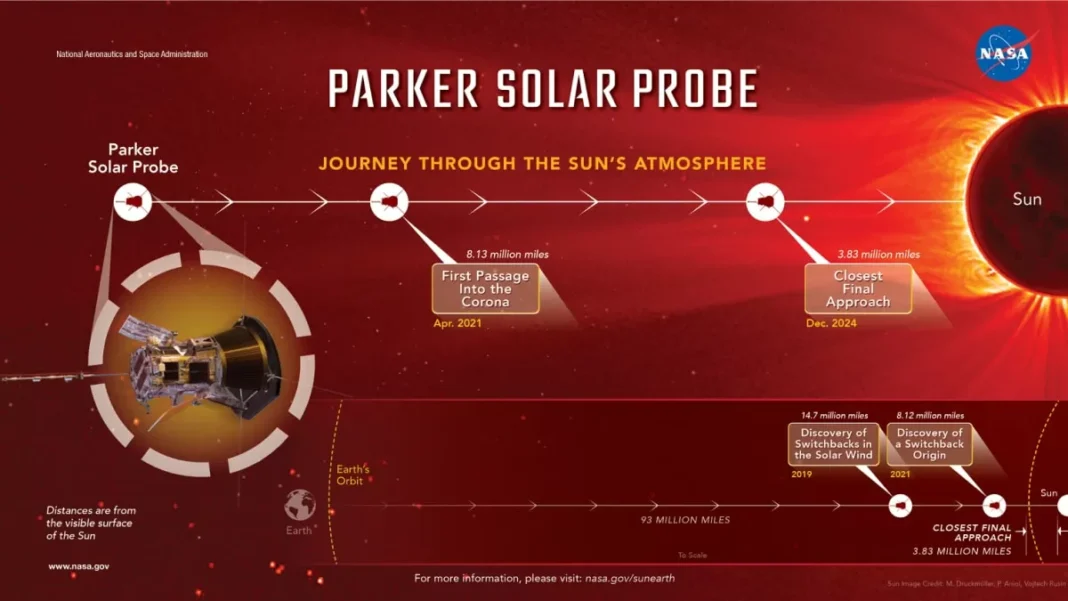NASA’s Parker Solar Probe has made history by coming closer to the Sun than any other spacecraft before it. On April 29, 2021, it reached a distance of 3.8 million miles from the Sun, traveling at a speed of 430,000 miles per hour. This incredible milestone is a result of years of hard work and dedication by the team at NASA, who have pushed the boundaries of space exploration with their innovative technology.
The Parker Solar Probe, named after astrophysicist Eugene Parker, was launched in 2018 with the aim of studying the Sun’s outer atmosphere, known as the corona, and its powerful solar winds. But to get close enough to the Sun, the spacecraft needed to overcome extreme temperatures and gravitational forces that could potentially destroy it. This is where the Venus flybys came into play.
Using a technique known as gravity assist, the Parker Solar Probe has been able to use the gravitational pull of Venus to adjust its orbit and get closer to the Sun. This has been crucial in enabling the spacecraft to achieve its historic feat, as it has to carefully navigate through the intense heat and radiation of the Sun’s atmosphere.
The spacecraft is equipped with advanced technology that allows it to withstand the extreme conditions near the Sun. Its heat shield, made of a carbon composite material, can withstand temperatures of up to 2,500 degrees Fahrenheit. This is essential for protecting the sensitive instruments onboard, which are responsible for gathering critical data about the Sun’s environment.
One of the main objectives of the Parker Solar Probe mission is to study the solar wind – a stream of charged particles that flow from the Sun and affect our entire solar system. By getting closer to the source of these winds, scientists hope to gain a better understanding of how they are created and how they impact Earth and other planets.
The spacecraft is also equipped with four sets of instruments that measure different aspects of the Sun’s environment. These include the FIELDS instrument, which measures electric and magnetic fields, and the WISPR instrument, which captures images of the solar corona. Together, these instruments provide valuable data that will help scientists unravel the mysteries of our closest star.
But the Parker Solar Probe’s journey is far from over. Over the next few years, it will continue to make more close approaches to the Sun, with the final goal of reaching a distance of 3.83 million miles from the Sun’s surface. This will bring it even closer to the Sun than the previous record holder, the Helios 2 spacecraft, which reached a distance of 27 million miles in 1976.
The data collected by the Parker Solar Probe will not only advance our understanding of the Sun, but also help us better predict and prepare for the effects of solar activity on Earth. Solar storms, for example, can disrupt satellite communications and even cause power outages on our planet. By studying the Sun up close, scientists hope to improve our ability to forecast and mitigate these potentially harmful events.
The success of the Parker Solar Probe mission is a testament to the incredible advancements in technology and the dedication of the team at NASA. With each new milestone reached, we are one step closer to unlocking the secrets of our solar system and the universe beyond.
In conclusion, the Parker Solar Probe has set a new standard for space exploration, pushing the boundaries of what we thought was possible. Its unprecedented milestone of coming 3.8 million miles from the Sun at a speed of 430,000 miles per hour is a testament to the ingenuity and determination of the human spirit. As we continue to explore the wonders of our universe, we can only imagine what other incredible feats await us in the future.


